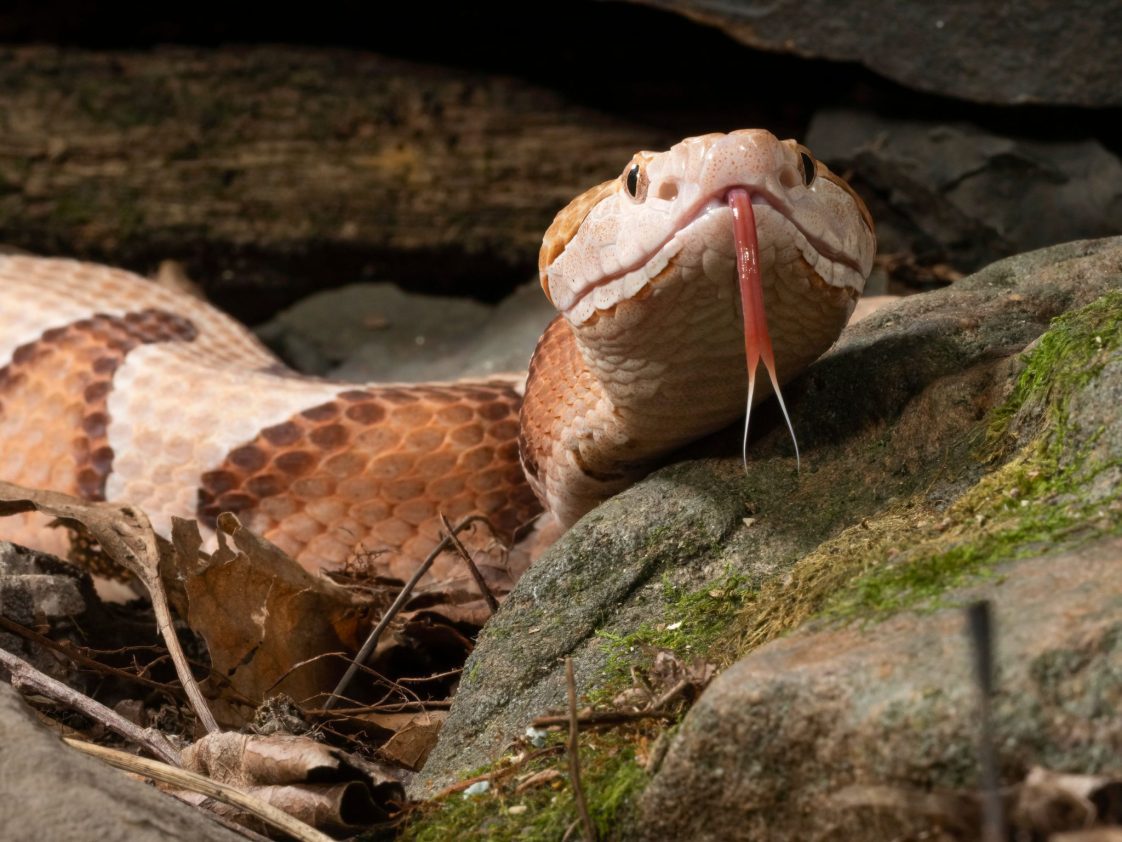Forestry & Wildlife

While the nights of early fall may be cooling down, that doesn’t mean that snakes are gone for the year just yet. In fact, late summer/early fall is an active season for snakes. Because of the cooler temperatures, many snake species are more active during the day. Also, late summer/early fall is baby snake season, where some species are giving birth to live young, and eggs that were laid earlier in the year are starting to hatch. When you combine these factors, the likelihood of encountering a snake increases. The following information explains how to handle a snake encounter.
Snake Identification
There are approximately 40 different species of snakes living in Alabama. Only six of these are venomous. It is important to be able to tell which snakes are venomous and which ones are not. Alabama’s six venomous snake species include the copperhead, cottonmouth, pygmy rattlesnake, timber rattlesnake, Eastern diamondback rattlesnake, and coral snake.
The first four occur throughout much of the state. The diamondback rattlesnake and coral snake are generally only found in southern Alabama. The coral snake, in particular, is exceedingly rare in the state. However, it is the most venomous snake in Alabama. The Alabama Extension publication Identification and Control of Snakes in Alabama provides information on what to look for to identify these venomous snakes. Also, see the Extension publication What’s Your Snake IQ? to test your snake knowledge.
Contact The Experts
If people are unsure whether a snake is venomous or not, ask for help. Alabama Extension wildlife specialists and regional agents are happy to identify snakes from photographs. People can send their photos by text or email. Also, there are several social media groups available that are devoted to snake identification, and can be a good resource. Knowing what snake species you saw can put your mind at ease.
Baby Snake Myths
Some people will claim that baby snakes are more dangerous than adults. While it is baby snake season, it is important to note that this idea is false. Baby snakes can control how much venom is injected, just like adults, and their venom is not more concentrated. Another myth is the existence of rattlesnake eggs. All pit vipers (rattlesnakes, copperheads, and cottonmouths) in Alabama give birth to live young, so rattlesnake eggs only exist in people’s imaginations.
A Snake In The Yard
If someone encounters a snake outside, the best option is usually to do nothing. Let it go about its business. While most people’s first instinct may be to kill it, many snakes provide valuable pest control services. Snakes aren’t aggressive and won’t chase people. However, if the snake does need to be moved, a garden hose is a great option that is within reach. One quick squirt of water will usually send the snake on its way.
A Snake In The House
If someone finds a snake in their house and they have confirmed that it is nonvenomous, they can simply pick it up and carry it outside. Many snake species will bite, but their teeth are small and any injuries sustained will be superficial. Alternatively, people can use a broom to sweep it out the door or into a bucket to be carried outside.
Oftentimes if a venomous snake is in the house, the best course of action is to call a wildlife removal expert. Your first call should be to someone on the Free Snake Relocation Directory if one is located nearby. These volunteers will safely capture and relocate any snake free of charge.
Snakebites
If bitten by a nonvenomous snake, people can simply treat the wound as if it were a cut or scrape. Venomous snakebites are uncommon. Although rarely fatal, they can be both dangerous and financially costly. Below are some do’s and don’ts if you are bitten by a venomous snake.
Do
- Call 911. The operator will inform you where to go.
- Get to the hospital. Have someone else drive you if possible.
- Note the location and time of the bite.
- Remove any jewelry or tight-fitting clothing.
- Keep the bitten extremity elevated.
- If possible, take a photograph of the snake, but this is not mandatory.
Don’t
- Try to kill the snake. You can be bitten again.
- Bring the snake–alive or dead–with you to the hospital. All copperhead, cottonmouth, and rattlesnake bites are treated with the same antivenom.
- Use tourniquets, cutting or suction, extraction devices, electrical stimulation, prolonged icing, caffeine, nicotine, or alcohol.
While scary, the most important thing to do after being bitten is to remain as calm as possible and get to the hospital.
More Information
People can contact Wesley Anderson with any additional snake questions or concerns.

